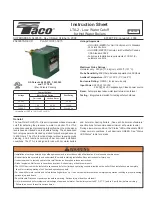
© The Fulton Companies 2012
INSTALLATION
RLN-IOM-2012-1205
SECTION 2
2-22
!
WARNING
All information in this manual is for
reference and guidance purposes,
and does not substitute for required
professional training, conduct,
and strict adherence to applicable
jurisdictional/professional codes and
regulations.
Do not use any dangerous source of
fi re or smoke (e.g., lighter, candle) to
test equipment at any time.
Assure all electrical connections are
powered down prior to attempting
replacement or service of electrical
components or connections of the
boiler.
4
CAUTION
Never install a barometric damper on
fl ue systems designed with positive
pressure.
¡
Air Piped From Outside Boiler Room
Adhere to the following:
1. The combustion air supply can be piped directly to the air inlet of the
boiler.
2.
A rubber air intake coupling is recommended with boilers specifi ed for
installation with ducted air supply. It must be used to connect the intake
piping to the boiler air inlet. This rubber air inlet coupling is available from
Fulton as an option. See Figure 6.
3. The air intake must be piped out of the building if the boiler room contains
contaminated air.
¡
Intake Duct Sizing
1. Air intake ducting must be sized in conjunction with the exhaust venting
to provide no greater than a +2.0” W.C. combined pressure drop. This
equates to 70 feet and 8 elbows when combining the distances on the
air intake and exhaust with the piping diameters matching the standard
connections.
2. The installation of a recognized termination screen is required. Contact
your local venting supplier for assistance in venting sizing.
3. Air Intake pipes and fi ttings shall be Schedule 40 PVC pipe or galvanized
steel. All Schedule 40 PVC pipe, fi ttings, primer and cement must conform
with American National Standard Institute and the American Society for
Testing and Materials (ANSI/ASTM standards.)
4. Intake PVC piping must be assembled using cement. This will ensure that
the intake is airtight and will not allow contaminates from the boiler room
into the boiler. The cement shall be free fl owing and contain no lumps,
un-dissolved particles or any foreign matter that adversely aff ects the joint
strength or chemical resistance of the cement. The cement shall not show
gelation, stratifi cation, or separation that cannot be removed by stirring.
}
CEMENTING JOINTS
The following procedure for cementing joints (per ASTM D2855) should be
adhered to:
1. Measure and cut PVC pipe to desired length.
2. Chamfer end of pipe, removing any ridges or rough edges. If end is not
chamfered, the edge of the pipe may remove cement from the fi tting
socket and result in a leaking joint.
3. Clean and dry the surfaces to be joined.
4. Test fi t joint and mark depth of fi tting on pipe outside.
5. Uniformly apply a liberal coat of primer to inside socket surface of fi tting
and male end of pipe to depth of fi tting socket.
Summary of Contents for Reliance 1000
Page 2: ......
Page 4: ...TheFultonCompanies2012 TABLEOFCONTENTS RLN IOM 2012 1205 0 2...
Page 42: ...TheFultonCompanies2012 OPERATION RLN IOM 2012 1205 SECTION3 3 12...
Page 50: ...TheFultonCompanies2012 MAINTENANCE RLN IOM 2012 1205 SECTION4 4 8...
Page 51: ......
Page 52: ......
Page 59: ......
















































